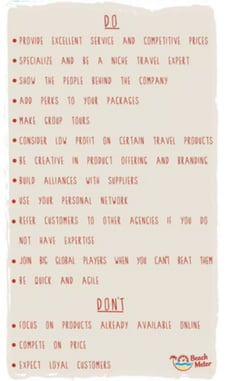Compelling Reasons to look for a Cloud-based ERP Travel Industry Solution
By David Eddy on Oct 29, 2015 7:00:00 AM

Two earlier posts addressed topics closely related to the subject of this blog: one covered the reasons why travel software-as-a-service (Travel SaaS) is an attractive technology model for companies in the this industry; the second discussed how the travel industry is using process automation to eliminate unnecessary costs from back office operations. This blog ties those two subjects  together by presenting compelling reasons why travel companies should take a close look at cloud-based enterprise resource planning (ERP) systems.
together by presenting compelling reasons why travel companies should take a close look at cloud-based enterprise resource planning (ERP) systems.
There must be compelling reasons for introducing any new technology into a travel company. While a great deal of industry literature seems predicated on the notion that more technology is always better than less, travel owners and managers can’t afford – literally or figuratively – to lose sight of how deploying new technology is always accompanied by unavoidable risks of disruption to operations and use of resources. A good practice is to identify and validate compelling reasons to run those risks. The criteria for being a compelling reason can include many things, but should certainly include benefits directly tied to continued survival, growth and profitability.
ERP as a Travel Industry Solution
These software systems are considered effective enterprise solutions for many industries because they have the capability to deliver an integrated suite of applications for front office, mid-office and back office business processes. The heart of their value proposition is a common data model and standardized processes across such primary software applications as: accounting, payroll; HR; supply chain, CRM & procurement.
When these systems first appeared in the 1990’s they delivered that functionality but also gained a reputation as large, complex systems which were challenging for customer to install, customize - and afford. In the last ten years they have become increasingly specialized by industry (travel ERP being one example) and much nimbler to deploy and implement. Vendors have also streamlined functionality and pricing to make them more affordable for smaller companies.
Throughout these changes, the key drivers of system value remain a common data model and standardized processes. These core features allow companies to avoid having numerous work-arounds by which data is passed from one software system to another (e.g. operations to payroll) or integrated manually for enterprise-wide reports. The systems are also configured to easily integrate with third party supplier or service (GDS) software.
When these features are mapped to a list of “do’s and don’ts”, the case for these systems having compelling reasons to be considered a travel solution becomes apparent.
Standardized Processes: this feature makes significant process automation possible. While eliminating manual activities is a smart move for any company, in the travel industry it means more than cost reduction. By minimizing ongoing manual process steps, employees are freed to focus on:
more than cost reduction. By minimizing ongoing manual process steps, employees are freed to focus on:
- Great customer service
- Becoming specialized travel experts
- Developing creative products and services
- Networking and social media promotions
- Responding quickly to changes to industry conditions and buying behaviors
Standardized Data and Easy 3rd Party Integration: this feature ignites the use of information as a means for a travel management company to create and maintain separation from its competitors. Having quick and easy access to accurate operational data and updated supplier information makes it possible for your company to:
- Offer accurate, competitive, prices
- Quickly customize travel packages without profit margin errors or oversights
- Easily create and price specialized group tours
- Experiment with product/margin mixes and accurately measure outcomes
- Focus on creative supplier alliances, confident data integration is handling the details
- Use supplier integration to quickly and accurately revise product offerings & pricing as needed
The Rationale for Cloud-based ERP
Rather than a conventional licensing arrangement, in which software is purchased, installed and hosted on the customer’s infrastructure, the Cloud refers to servers and software residing in physical locations and accessed via the Internet by a web browser.
The cloud version of TINA, dcs plus mid back office is an example of such a solution. It runs on a central server which stores the databases; the travel company accesses it via a web browser, based on account and role-based security, using a standard TCP/IP connection and without any additional software. Just that simple connection provides all the functionality a travel company could require: including, Corporate Travel; Leisure; Tour Operating or PCOs.
The overall advantages of such a solution includes:
Quick & Easy Deployment: Because the system already resides on either vendor or third party servers, the deployment for the individual customer simply consists of a thin client configuration which provides browser-based, user interface (UI) Internet access. Typically this deployment is a matter of hours or less.
Affordable, Variable, Expenses: because the system is already deployed and hosted on vendor or third party servers, there is no capital investment requirements for new customers. Instead, customers are charged for usage – often termed as “software priced by the drink”. Not only does this feature attractively match use with benefits, it is particularly beneficial for small companies just starting to grow.
Timely Upgrades: not only does a cloud-based technology model allow customers to avoid an initial capital expenditure, it also enables them to enjoy timely system upgrades with costs limited to variable usage charges. This keeps system functionality current and competitive without untimely out-of-pocket outlays.
Multi-Tenancy: this means many customers are simultaneously accessing the hosted system and enjoying mutual benefits. These benefits not only include the absence of capital investment previously discussed, but also security and availability resources reflecting the importance of the entire customer base.
Minimal Support Costs: the system vendor owns the accountability for performance and service levels 24/7/365 – and the resources and experiences to back it up. These services are included in the ongoing usage charges. On the other hand, with an individually licensed and maintained application this expense would be borne solely by the customer.
This combination of powerful system features and an affordable, variable, cost model does provide compelling reasons to view cloud-based, enterprise resource planning software to be a key travel solution.
The capability it provides for companies to make quick decisions based on accurate, timely, information is an invaluable competitive edge. The savings it enables through process automation creates an attractive ROI proposition. This technology may not be right for every travel company, but every travel company should give it a close, hard, look.
- travel technology (58)
- Travel Industry (49)
- travel agency (31)
- travel erp (31)
- travel trends (28)
- travel booking system (23)
- TINA (21)
- travel company (19)
- Tour Operator (18)
- Product updates (17)
- Travel Management Company (17)
- AIDA (15)
- TBS (15)
- dcs plus news (14)
- tour operator solution (14)
- travel website (14)
- travel erp system (13)
- Business Travel (12)
- Mobile App (12)
- Travel App (12)
- mid back office solution (12)
- trends (12)
- Industry Events (11)
- Mobile Technology (11)
- TMC (11)
- travel agents (11)
- erp (10)
- erp system (10)
- Corporate Travel (9)
- Tour Operators (9)
- Travel booking engines (9)
- dcs plus (9)
- online travel agency (9)
- travel agent (9)
- Mobile Bookings (8)
- travel (8)
- travel agencies (8)
- 2017 (7)
- Mobile Travel (7)
- travel business (7)
- travel software (7)
- Digital Technology (6)
- Insider (6)
- Millennials (6)
- Online booking systems (6)
- Travel Management Companies (6)
- process automation (6)
- travel companies (6)
- Big Data (5)
- Business Traveler (5)
- Partners interviews (5)
- Tour Operator Software (5)
- customer retention (5)
- travel agency technology (5)
- Booking engines (4)
- CSBT (4)
- Mobile Device (4)
- OTAs (4)
- Static databases (4)
- Tour Companies (4)
- Travel Policy (4)
- Travel booking systems (4)
- Travel suppliers (4)
- back office automation (4)
- millennial travelers (4)
- online travel (4)
- responsive travel website (4)
- technology (4)
- travel website conversion (4)
- 2016 (3)
- Content mapping (3)
- Databases (3)
- Demographics (3)
- Food and Adventure Tourism (3)
- Mobile Apps (3)
- Mobile travel apps (3)
- Travel Distribution Channels (3)
- Travel Management Software (3)
- Travel customers (3)
- Travel history (3)
- anniversary (3)
- automated processes (3)
- content matching (3)
- global travel industry (3)
- social media (3)
- travel agency workflow (3)
- travel back office (3)
- travel marketing (3)
- travel process automation (3)
- Advanced Booking Systems (2)
- B2B Travel Resellers (2)
- Bleisure (2)
- Branding (2)
- Business Process Automation (2)
- Business Travelers (2)
- Customer engagement (2)
- Financial Reporting (2)
- Food Tourism (2)
- Inbound Marketing (2)
- Infographic (2)
- Leisure Travel (2)
- Saas (2)
- Templates (2)
- Travel Costs (2)
- Travel bookings (2)
- Travel start-up (2)
- Travel website abandonment (2)
- WTM 2016 (2)
- abandoned travel bookings (2)
- corporate self booking tool (2)
- engagement marketing (2)
- internet booking engine (2)
- millennial traveler (2)
- new travel company (2)
- office (2)
- online reputation management (2)
- online travel reviews (2)
- reporting (2)
- software (2)
- start-up tips (2)
- travel agency management (2)
- travel agency website (2)
- travel experience (2)
- travel mobile app (2)
- travel packages (2)
- travel reservation system (2)
- travel system (2)
- travelers (2)
- web-based travel erp (2)
- 2020 (1)
- 360 Customer View (1)
- Advanced Accommodation Contract Management (1)
- Adventure travelers (1)
- Apps (1)
- B2B Reseller (1)
- B2B Resellers (1)
- B2C (1)
- BI Reporting (1)
- Budget traveler (1)
- Cancellations (1)
- Chat (1)
- Chinese millennial (1)
- Cloud (1)
- Cognitive computing (1)
- Comparison shopping (1)
- Conference (1)
- Contact matching (1)
- Content (1)
- Cruise (1)
- Culinary traveler (1)
- Customer relations (1)
- Digital Innovation (1)
- Digital Natives (1)
- Documents (1)
- Emerging market travelers (1)
- Emerging markets (1)
- Errors (1)
- Experimental travel (1)
- Financial Dashboard (1)
- Import rates (1)
- Instant messaging (1)
- Integrate with Accounting Software (1)
- Internet (1)
- Luxury traveler (1)
- Mobile Transaction (1)
- Mobile payments (1)
- NDC distribution (1)
- Operational Reporting (1)
- Reseller networks (1)
- Resellers (1)
- Response (1)
- Subagents Network (1)
- TINA Academy (1)
- TTE (1)
- Travel Reseller Network (1)
- Travel Revenue Management (1)
- Travel booking problems (1)
- Travel finance reporting (1)
- Travel stats (1)
- WTM (1)
- abandonment (1)
- accomodations (1)
- advanced reporting (1)
- airline direct connect technology (1)
- ancillary services (1)
- cloud computing (1)
- collection (1)
- collection challenges (1)
- common data model (1)
- conversion rates (1)
- cost control (1)
- credo ventures capital invests in dcs plus (1)
- customer reviews (1)
- data analysis (1)
- dcs plus credo investment (1)
- dcs plus credo ventures (1)
- deloitte technology fast 500 EMEA (1)
- digital transformation (1)
- e-invoicing KSA (1)
- email marketing (1)
- email marketing for OTAs (1)
- erp e-invoicing (1)
- lost travel bookings (1)
- modern travel agencies (1)
- networks (1)
- new features (1)
- offers (1)
- online customer review (1)
- online reputation (1)
- online travel agencies (1)
- risk management (1)
- sales (1)
- senior travelers (1)
- shopping baskets (1)
- shopping carts (1)
- social network (1)
- standardized processes (1)
- static content (1)
- travel SaaS (1)
- travel account services (1)
- travel agency customers (1)
- travel agency profitability (1)
- travel analytics (1)
- travel blog (1)
- travel planning (1)
- travel reviews (1)
- travel shopping carts (1)
- travel software for agencies (1)
- travel software system (1)
- travel technology europe (1)
- travlist smart mobile app (1)
- trend (1)
- trusted adviser (1)
- trusted advisor (1)
- upsell functionality (1)
- vouchers (1)
- website traffic (1)
- zatca (1)
Subscribe by email
You May Also Like
These Related Stories

Three Types of Reports – every Travel Company Needs

How to Help Your B2B Travel Resellers


No Comments Yet
Let us know what you think